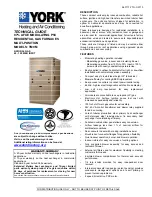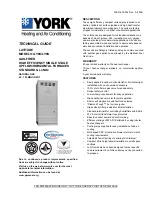
PRODUCT DESIGN
42
Rev. 0
•
Use listed gas appliance connectors in accordance
with their instructions. Connectors must be fully in
the same room as the furnace
•
Protect connectors and semirigid tubing against
physical and thermal damage when installed. Ensure
aluminum-alloy tubing and connectors are coated to
protect against external corrosion when in contact
with masonry, plaster, or insulation, or subjected to
repeated wetting by liquids such as water (except rain
water), detergents, or sewage.
CAUTION
Edges of sheet metal holes may be sharp. Use gloves
as a precaution when removing hole plugs.
Direct/Standard Inlet Piping
When gas piping enters
directly to the gas valve through
the
standard inlet hole (upflow through the right side panel;
counterflow, through the left side panel), the installer must
supply straight pipe with a ground joint union to reach the
exterior of the furnace. The rigid pipe must be long enough
to reach the outside of the cabinet to seal the grommet
cabinet penetration. A semirigid connector to the gas pip-
ing can be used outside the cabinet per local codes.
Indirect/Alternate Inlet Piping
When gas piping enters
indirectly to the gas valve through
the
alternate gas inlet hole (upflow through the left side
panel; counterflow, through the right side panel), the in-
staller must swap the alternate inlet hole plug with the stan-
dard inlet grommet and supply the following fittings (start-
ing from the gas valve) to reach the outside of the cabinet:
•
Coupling.
•
90 degree elbow.
•
2 inch close nipple.
•
90 degree elbow.
•
Straight pipe, with a ground joint union, to reach the
exterior of the furnace. The rigid pipe must be long
enough to reach the outside of the cabinet so as to
seal the grommet cabinet penetration. A semirigid
connector to the gas piping can be used outside the
cabinet per local codes.
Gas Piping Checks
Before placing unit in operation, leak test the unit and gas
connections.
WARNING
To avoid the possibility of explosion or fire, never use
a match or open flame to test for leaks.
Check for leaks using an approved chloride-free soap and
water solution, an electronic combustible gas detector, or
other approved testing methods.
Note: Never exceed specified pressures for testing. Higher
pressure may damage the gas valve and cause subsequent
overfiring, resulting in heat exchanger failure.
Disconnect this unit and shutoff valve from the gas supply
piping system before pressure testing the supply piping sys-
tem with pressures in excess of 1/2 psig (3.48 kPa).
Isolate this unit from the gas supply piping system by clos-
ing its external manual gas shutoff valve before pressure
testing supply piping system with test pressures equal to or
less than 1/2 psig (3.48 kPa).
Propane Gas Tanks and Piping
WARNING
Propane gas is heavier than air and any leaking gas
can settle in any low areas or confined spaces. To pre-
vent death, personal injury, or property damage due to
fire or explosion caused by a propane gas leak, install
a gas detection warning device.
A gas detecting warning system is the only reliable way to
detect a propane gas leak. Rust can reduce the level of
odorant in propane gas. Do not rely on your sense of smell.
Contact a local propane gas supplier about installing a gas
detecting warning system. If the presence of gas is sus-
pected, follow the instructions on Page 6 of this manual.
All propane gas equipment must conform to the safety stan-
dards of the National Board of Fire Underwriters, NBFU
Manual 58.
For satisfactory operation, propane gas pressure must be
11 inch WC at the furnace manifold with all gas appliances
in operation. Maintaining proper gas pressure depends on
three main factors:
1. Vaporization rate, depending on temperature of the liq-
uid, and “wetted surface” area of the container or con-
tainers.
2. Proper pressure regulation. (Two-stage regulation is
recommended for both cost and efficiency).
3. Pressure drop in lines between regulators, and between
second stage regulator and the appliance. Pipe size will
depend on length of pipe run and total load of all appli-
ances.
Complete information regarding tank sizing for vaporiza-
tion, recommended regulator settings, and pipe sizing is
available from most regulator manufacturers and propane
gas suppliers.
Since propane gas will quickly dissolve white lead and most
standard commercial compounds, special pipe dope must
be used. Shellac-based compounds resistant to the actions
of liquefied petroleum gases such as Gasolac
®
, Stalactic
®
,
Clyde’s
®
or John Crane
®
are satisfactory.













































